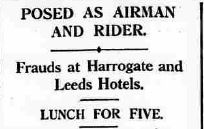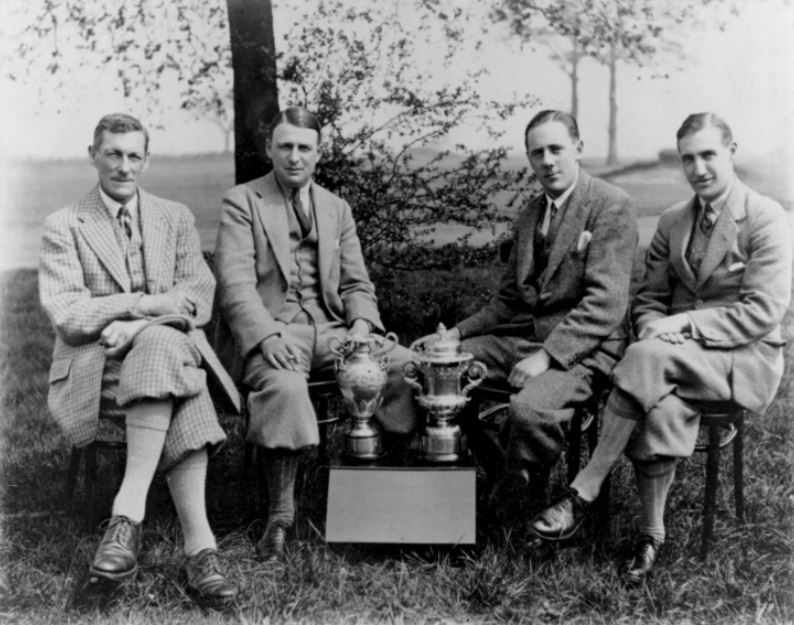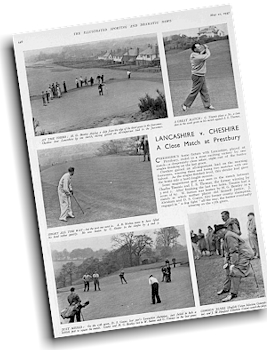The Early Years
1921, the first season of the newly formed Cheshire Union of Golf Clubs, was extremely successful and gave much optimism for the future.
On Saturday 11th June, the county held its first inter-county match, against neighbours Lancashire at Royal Liverpool. Cheshire were keen to field their strongest team, and manged to recruit the legendary John Ball,then 59 years of age, to captain the side. The team that day was:
| John Ball Jr. (Royal Liverpool) | J.Brown |
| Froes Ellison (Royal Liverpool) | Geoffrey Tweedale (Wilmslow) |
| C.Ashbrook (Stockport) | Israel Sidebottom (Stockport) |
| Kenneth Stoker (Royal Liverpool) | W.B.Charles (Royal Liverpool) |
| W.Walker | Ernest Hassall (Bromborough) |
| Martin Schunck (Hale) | A.H. Reynolds (Wallasey) |
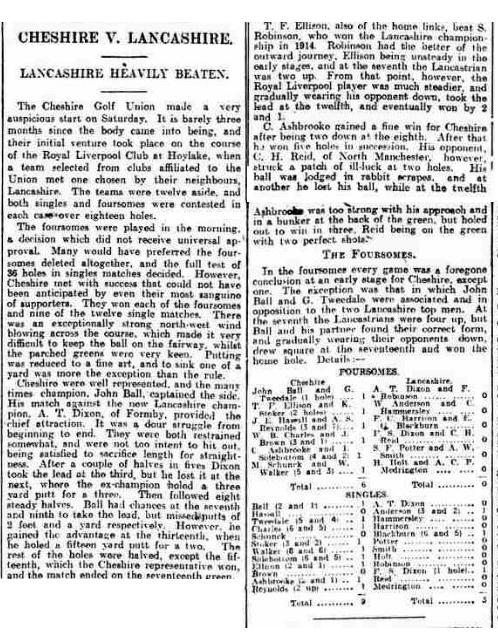
The account of the match shows that Cheshire totally dominated Lancashire, running out 15-3 winners. In fact, this remains our biggest ever win over the Red Rose county!
The 40 affiliated clubs had all contributed towards the cost of a magnificent County Championship trophy, which was played for over the Delamere Forest course between 5th and 8th July. The championship attracted a large entry of 103 players from across the county, no doubt the quality of the course adding to the enticing prospect of becoming the first Cheshire champion. In addition to the gross championship, there were two handicap divisions. The President of Sale G.C., presented a trophy for the team competiton. A newspaper reported that the greens were "perfectly true". Were they ever anything else at Delamere?!
Here is a newspaper report of the semi-finals and final.
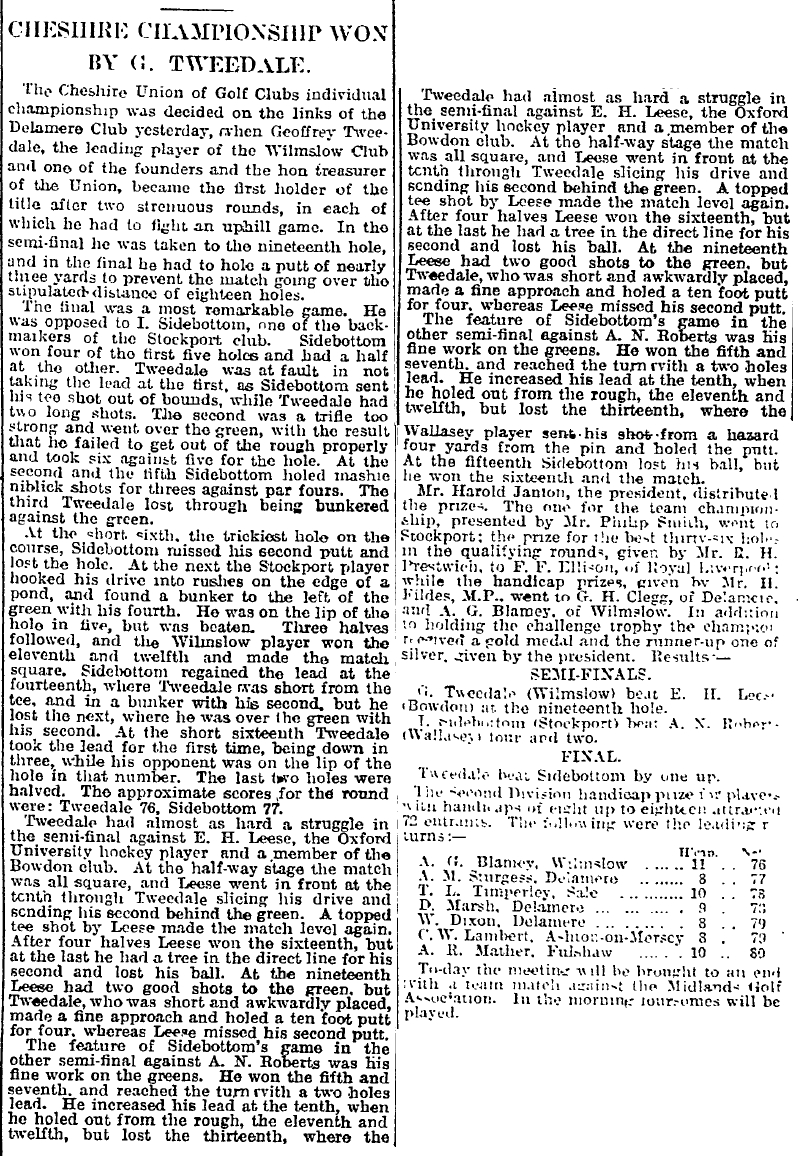
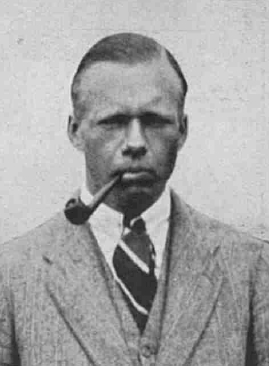 |
| Geoffrey Tweedale |
The winner was Geoffrey Tweedale of Wilmslow GC (and also the CUGC Treasurer), who beat Israel Sidebottom in a very close final (until 1961, the championship format was stroke play qualifying followed by match play).
The team championship was won by Stockport, represented by Israel Sidebottom (155) Norrie Sidebottom (155), S.S. Potter (157) and C.Ashbrook (158).
On the day after the championship, Cheshire played the Midlands Counties at Delamere, again with John Ball at the helm. Cheshire won 11½to 6½
Cheshire subsequently played matches against Yorkshire at Lindrick, losing 5 &frac1/2; to 12 &frac1/2;, but winning the return 9&frac1/2; 8 ½ at Wilmslow. An away fixture with Lancashire at Manchester G.C resulted in a 9 - 9 draw. The Midland Counties hosted a return match at Little Aston, Cheshire losing 12.5 5.5 . Fixtures with the Midlands were to last only until 1923, after which annual matches with Worcestershire and Derbyshire were played.
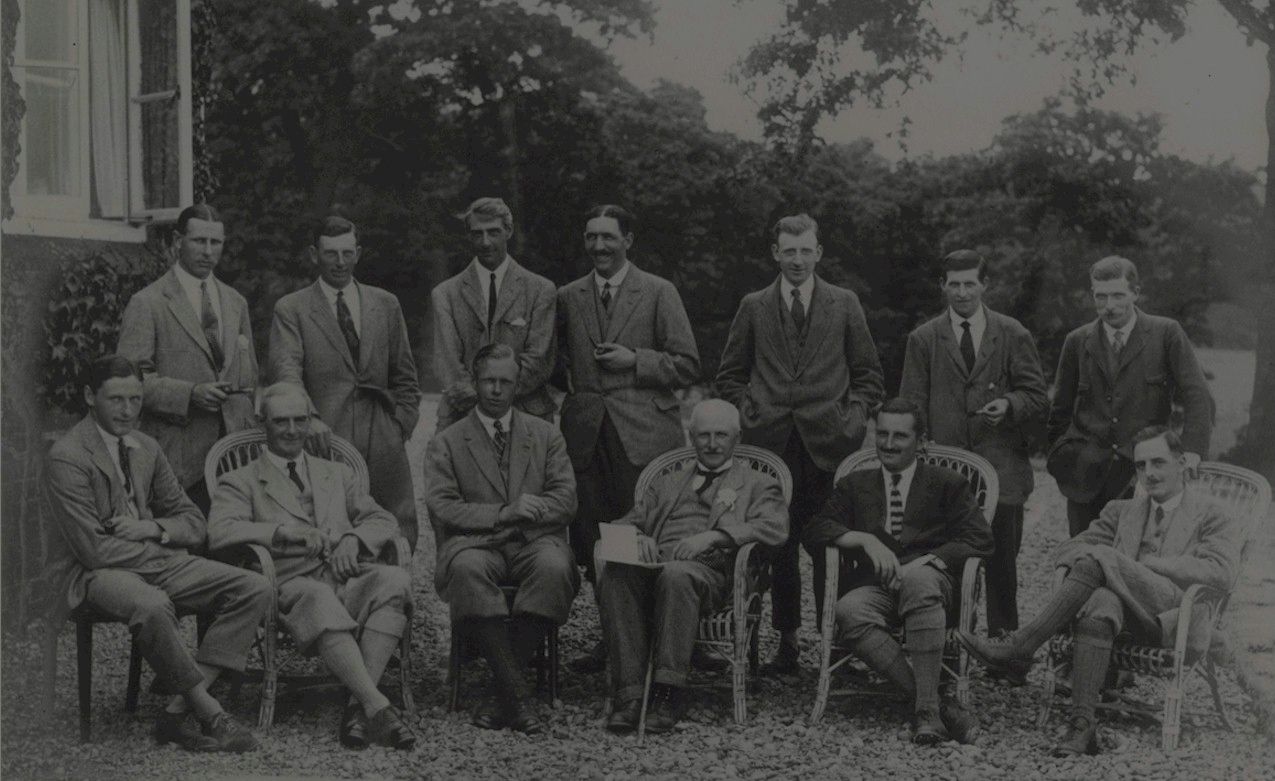
The Cheshire team to play the Midlands Counties, 9th July, 1921 at Delamere Forest G.C.
Back row l to r: G.Q.Dinn (Heswall), J.E.Hassall (Bromborough), W.B.Charles (Royal Liverpool), D.Brown (Royal Liverpool), C.Ashbrook (Stockport), T.N.Sidebottom (Disley), I.Sidebottom (Stockport)
Front row l to r: T.F.Ellison (Royal Liverpool), J.Ball Jr. (Royal Liverpool), G.Tweedale (Wilmslow), D.T.Mylrea (CUGC Secretary, Sale), G.B.Farrar (Royal Liverpool), D.Berry (Timperley)
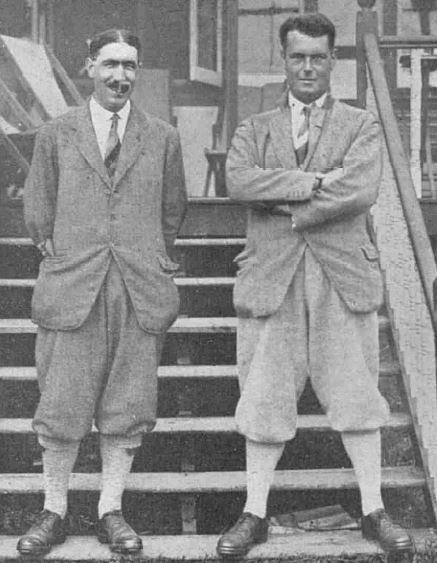 |
| David Brown (Royal Liverpool) left, with Cyril Tolley prior to contesting the final of the Welsh Open Amateur Championship at Porthcawl, 1921. Tolley won 3&1. |
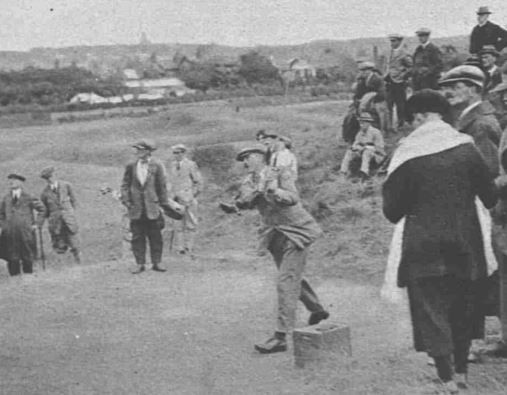 |
| Allan J.Graham drives in the Amateur final at Hoylake |
The 1921 Amateur Championship was played at Royal Liverpool, which perhaps explains why the inaugural County Championship was not played over the Hoylake links. Royal Liverpool member, Allan J. Graham, nephew of the renowned Jack Graham, famously despatched Bobby Jones on his way to a final that he lost to W.I. Hunter.
In 1922 it was the intention to hold the County Championship at Royal Liverpool. The long drought of 1921, however, had left the links in a poor condition and the decision was made to move the championship to Prenton G.C.
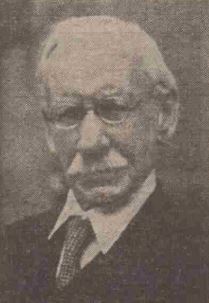 |
|
R.H.Prestwich (Delamere Forest) CUGC President 1922-28 |
Ironically, there was heavy rain during the championship and it was lucky to survive the monsoon-like conditions. Geoffrey Tweedale retained his title, beating Ernest Hassall of Bromborough, and the winning club team was Royal Liverpool, who won by a shot from holders Stockport.
Harold Janion, a revered personality within the game, sadly passed away suddenly on the eve of the 1922 Championship, and his replacement as President was R.H.Prestwich, who held the position until 1928.
1923 saw the first County Foursomes championship, held at Delamere Forest. Israel Sidebottom and S.S.Potter of Stockport were the winners.
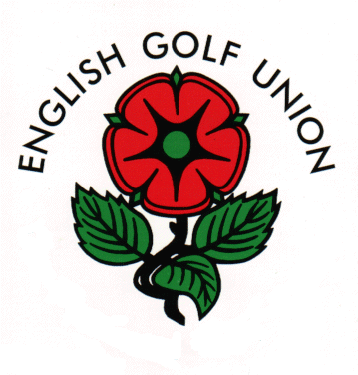
The lack of a ruling body for amateur men's golf in England was rectified in 1924 following a proposal by the Lancashire Union of Golf Clubs, and at a meeting in Manchester in February, 1924, The English Golf Union came into being. It's primary objectives were to:
- Apply a uniform handicapping system across all English clubs
- Establish a national championship, sectional competitions and such international matches as the committee saw fit
- Further the interests of the game in England
The Lancashire, Cheshire and Yorkshire Unions were tasked with producing a constitution and rules for the EGU, and Geoffrey Tweedale was elected the Hon Treasurer. Major Forbes-Bell, the Royal Liverpool secretary, was appointed Hon Secretary of the EGU. It is clear that in some quarters the EGU was seen as a threat to the status of the R&A as the ruling body for the game, a friction that was to persist for several years.
The EGU introduced a Standard Scratch Score and Handicapping Scheme in 1926, aimed at standardising handicaps across England. It did not, however, meet with universal acclaim, and in some areas was met with nothing short of outright hostility from clubs. Even seven years later some clubs refused to have an EGU S.S.S. assessment.
At the 1925 AGM of the CUGC, it was reported that there were now 55 affiliated clubs.
In 1925, the EGU held its first English Amateur Championship at Royal Liverpool. This was won by Cheshire's Thomas Froes Ellison. Remarkably, he was to repeat his success at Walton Heath in 1926. The EGU held its first County Championship at Formby in 1926, with teams of three representing each county over 36 holes stroke play. The team selected by the Cheshire Union was Israel Sidebottom (Stockport), Ernest Hassall (Bromboroughl) and Eustace Landale (Royal Liverpool). Hassall, however, withdrew on the morning of the championship with a poisoned
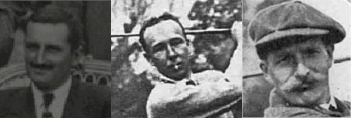 |
| The winning team: Farrar, Landale and Sidebottom |
hand, resulting in Guy Farrar of RLGC making a dash over to Formby as stand-in. He performed well, and Cheshire prevailed by seven shots over Surrey with Lancashire third. Things could not have looked much better for Cheshire golf: inaugral County Champions and, in Froes Ellison, a double winner of the English Amateur. The Cheshire team were less fortunate two years later, when M.Schunck (Hale G.C.) was disqualified on only the third hole in the English Counties Championship, meaning Cheshire could not complete a team score. For reasons unknown, Cheshire did not enter a team in the 1930 English Counties Championship.
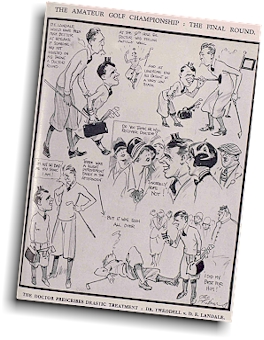 1927 saw the Amateur Championship hosted at Royal Liverpool. It was contested by an extremely strong field. Royal Liverpool member and Cheshire county player, Eustace Landale made his mark by progressing to the final where he met the renowned Dr William Tweddell of Stourbridge G.C. Landale suffered a thumping 7&6 loss in the final, but perhaps did not deserve this rather cruel characterisation of the final that appeared in the press (click to enlarge).
1927 saw the Amateur Championship hosted at Royal Liverpool. It was contested by an extremely strong field. Royal Liverpool member and Cheshire county player, Eustace Landale made his mark by progressing to the final where he met the renowned Dr William Tweddell of Stourbridge G.C. Landale suffered a thumping 7&6 loss in the final, but perhaps did not deserve this rather cruel characterisation of the final that appeared in the press (click to enlarge).
Cheshire produced another English Amateur Champion in 1929, in the form of Bill Sutton from the Artisans section fo West Cheshire Golf Club. Sutton went on to win the 1930 Irish Amateur Championship and also progressed to the quarter final of that year's Amateur Championship.
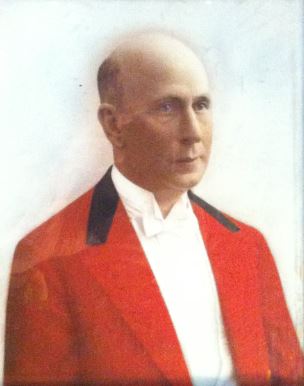 |
| "Bim" Baxter (picture courtesy of Royal Livepool G.C.) |
An interesting character who was President in 1929 was James "Bim" Baxter. He'd won three rugby union caps for England in 1900 (he played his club rugby at Birkenhead Park) and a silver medal at sailing in the 1908 London Olympics. In actual fact, there were only two entries for the 12m class, one being from Glasgow where the races were held. Bim went on to be President of the RFU in 1926/7 and to manage two British Lions tours, to Argentina and to Australia / New Zealand in 1930. He caused huge controversy in New Zealand when, during a formal speech, he accused the All Blacks captain's tactics in the scrum as nothing short of cheating. He was Royal Liverpool GC captain in 1926.
Strange incidents are not uncommon in the game of golf, however the proceedings that involved a Cheshire player, C.K. Parker (Warrington G.C.) after an away match with Yorkshire in 1928 are really quite bizarre. Click on the headline to read the report describing the court case which followed.
Ringway G.C, 1929 Team Championship Winners
C.R. Darlington, C.Hammersley, J.Braid Jr (County Champion), J.D. O'Hanlon
(picture courtesy of Ringway G.C.)
1931 saw the first County Colts match against Lancashire, aimed at developing younger players in the respective counties. This became an annual match, and in the mid 1950s fixtures with other counties in the North and Midlands were added.
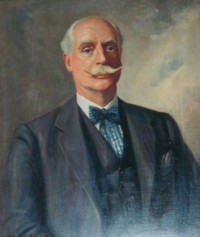 |
|
On 16th May, 1932, at Wallasey G.C., the stableford scoring system was played for the first time. The brainchild of Dr Frank Stableford, this scoring system rapidly gained mass acceptance across the golfing world.
|
The west of the county was certainly a hot bed of golfing talent. John Woollam of the now defunct Hooton club was emerging as a fine player, and won the 1933 English Amateur Championship at Ganton. To confirm his class, he emulated Ellison by winning it again in 1935 at Hollinwell. In the eleven years the EGU had been in existence, Cheshire had won the County Championship, provided two double winners and a further winner of the English Amateur, plus a double semi-finalist. Cheshire's dominance of English amateur golf was complete. It is likely that, if you'd forecast then that Cheshire would not have another English Amateur champion for 70 years, few in Cheshire golfing circles would have believed you. However, that is exactly what happened.
In 1935, Derbyshire ended their 12 year losing sequence against Cheshire by winning their match at Buxton and High Peak. Ironically, the Derbyshire team contained Martin Schunck who had made 38 appearances for Cheshire before moving to Derbyshire.
The County were probably pleased to see the back of 1936.There was a mix up over the date of Cheshire's home fixture with Derbyshire. The visitors arrived at Ringway G.C. to find that the hosts had the date down for the following week and were, in fact, playing against Lancashire that day. In the same year, the county were unable to raise a team for the away match with Yorkshire, and it had to be re-arranged.
Golf was thriving across the country, and no more so than in Cheshire with new clubs regularly appearing. Sandiway and Prestbury had opened in the early 1920s and both were from the outset, and are so today, strong supporters of the CUGC. The number of affiliated clubs had grown beyond 60 by 1937.
During the early 1930s individual membership of county unions became popular. The "County Card" scheme in Cheshire involved a payment of 10s, which included a badge and a tie. Royal Liverpool were the first club to sign up the the scheme, and by 1936 there were 250 Cheshire golfers registered, and able to play on many of the county's courses at half the normal green fee. In 1936 Delamere Forest was the most visited club under the scheme.
In May 1937, Prestbury hosted the Cheshire versus Lancashire fixture, which was reported in the Illustrated Sporting and Dramatic News. This is a rare article on county golf, and illustrates the significant changes to the landscape of the Prestbury course.
In 1938 two Cheshire players were short-listed for the Walker Cup, to be played at St Andrews. J.A. Graham of Royal Liverpool had attracted the eye of selectors, as, to surprise in some quarters, did E.Bromley-Davenport of Wilmslow. Unfortunately, neither made it into the team.
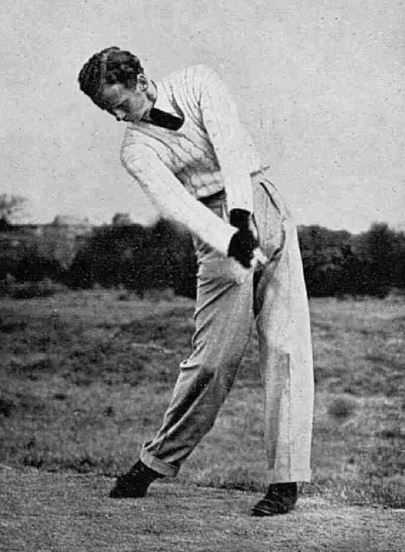 |
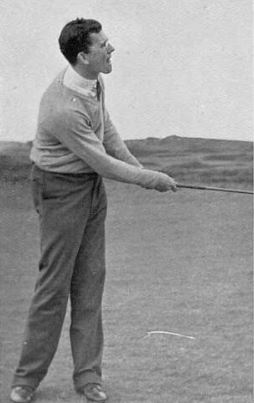 |
|
| John A. Graham | E. Bromley-Davenport |
Bromley-Davenport, who'd won the County Championship in 1938, put up a gallant defence of his title, losing in the 1939 final to the Sandiway Secretary, Maurice Budd, who would soon become the County Secretary following the call up of the incumbent, G.A. Armitage, for military duty.
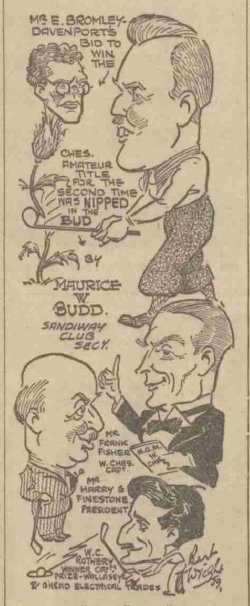 |
Competitive golf was to cease for six years following the outbreak of WWII and many of the 65 clubs then forming the Cheshire Union would struggle just to survive six years of war.

